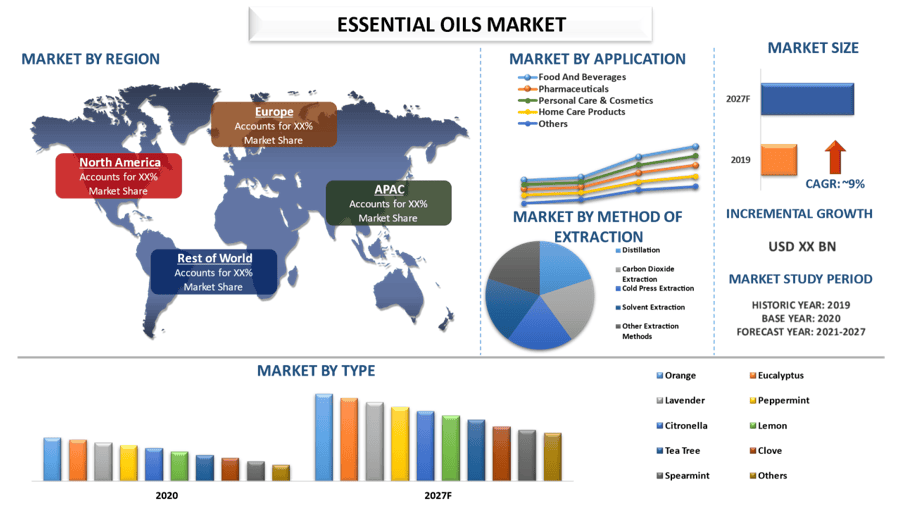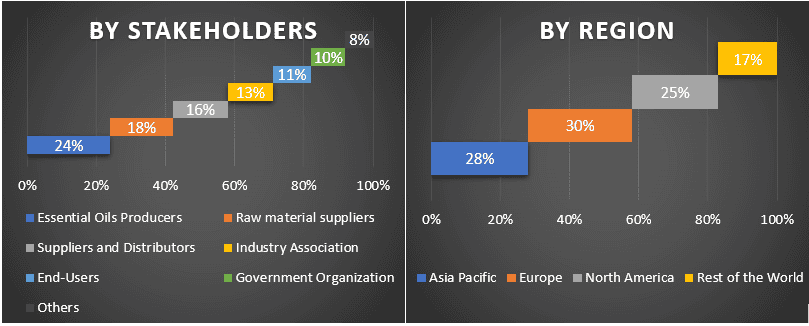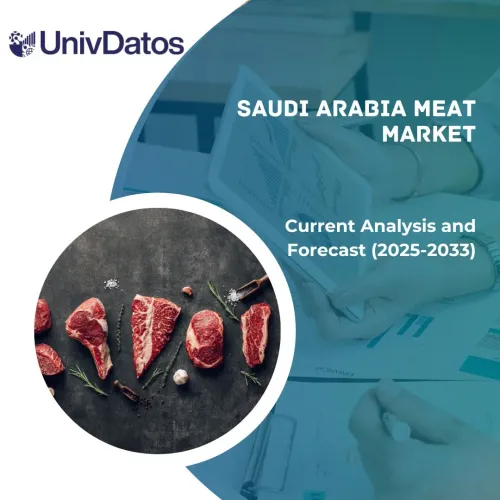エッセンシャルオイル市場:現状分析と予測(2021年~2027年)
タイプ別(オレンジ、ユーカリ、ラベンダー、ペパーミント、シトロネラ、レモン、ティーツリー、クローブ、スペアミントなど)、抽出方法別(蒸留、二酸化炭素抽出、低温圧搾抽出、溶剤抽出など)、用途別(食品・飲料、医薬品、化粧品・パーソナルケア、ホームケアなど)、地域・国別

エッセンシャルオイル市場は、予測期間中にCAGR約9%で成長すると予想されています。エッセンシャルオイル市場の成長に影響を与える主な要因は、アロマセラピーの需要の増加、食品・飲料および化粧品におけるエッセンシャルオイルの使用の増加です。アロマセラピーとは、エッセンシャルオイルを使用する一連の伝統的、代替的、または補完的な療法を指します。さらに、エッセンシャルオイルは、吐き気、痛み、体の痛み、不安、興奮、ストレス、うつ病、疲労、不眠症の軽減に役立ちます。ストレス、うつ病、疲労は、都市化の進展に伴い増加している一般的な問題です。さらに、食品業界は主にエッセンシャルオイルを香料として使用しており、食品保存のための天然抗菌剤の供給源となっています。
レポートで提示される洞察
「タイプ別では、オレンジエッセンシャルオイルカテゴリーが2020年に主要な市場シェアを占めました」
タイプに基づいて、市場はオレンジ、ユーカリ、ラベンダー、ペパーミント、シトロネラ、レモン、ティーツリー、クローブ、スペアミント、その他に分類されます。2020年、オレンジエッセンシャルオイルは、世界のエッセンシャルオイル市場の重要なシェアを占めました。このセグメントの収益成長は、オレンジエッセンシャルオイルの抗菌活性と鎮痛効果によって牽引されています。オレンジエッセンシャルオイルには、主な抗菌剤としてd-リモネンが含まれており、潜在的な抗菌剤となっています。さらに、オレンジエッセンシャルオイルには天然の抗酸化物質が含まれており、炎症を軽減するのに役立ちます。
「抽出方法別では、蒸留カテゴリーが市場でかなりのシェアを占めました」
抽出方法に基づいて、エッセンシャルオイル市場は、蒸留、二酸化炭素抽出、コールドプレス抽出、溶媒抽出、その他に分類されています。これらのうち、蒸留抽出法は、2020年に世界のエッセンシャルオイル市場でかなりのシェアを占めており、予測期間中に堅調な成長率で成長すると予想されています。蒸留抽出法の効率が、このセグメントの成長を牽引する主な要因です。さらに、蒸留とは、液体を蒸気に変換し、その後液体状態に戻すプロセスです。蒸留は、金属、硝酸塩、微生物などの無機化合物を効果的に除去します。
「ヨーロッパは、世界のエッセンシャルオイル市場で主要なシェアを占めました」
ヨーロッパは、世界のエッセンシャルオイル市場で重要なシェアを占めており、予測期間中に堅調な成長率で成長すると予想されています。アロマセラピーの需要の増加と研究開発活動の成長が、ヨーロッパにおけるこの市場の成長を牽引しています。エッセンシャルオイル市場の成長のもう1つの理由は、ヨーロッパの消費者が健康を改善および維持するためのより自然な方法を探していることです。その結果、ヨーロッパではエッセンシャルオイルの需要が増加しています。エッセンシャルオイルは多くの有益な特性を提供するため、この傾向は続くと予想されます。
市場で活動している主要なプレーヤーには、Cargill Inc.、Firmenich SA、Rocky Mountain Oils LLC、Young Living Essential Oils LC.、Sydney Essential Oil Company、Essential Oils of New Zealand Ltd.、Robertet SA、The Lebermuth Company Inc.、Givaudan SA、West India Spices Inc.などが含まれます。
このレポートを購入する理由:
- この調査には、認証された主要な業界専門家によって検証された市場規模と予測分析が含まれています
- レポートは、全体的な業界パフォーマンスの簡単なレビューを一目で示します
- レポートは、主要なビジネス財務、製品ポートフォリオ、拡張戦略、および最近の動向に主な焦点を当てて、著名な業界ピアの詳細な分析を網羅しています
- 業界で普及している推進要因、制約、主要なトレンド、および機会の詳細な調査
- この調査は、さまざまなセグメントにわたる市場を包括的に網羅しています
- 業界の掘り下げた国レベルの分析
カスタマイズオプション:
世界のエッセンシャルオイル市場は、要件またはその他の市場セグメントに応じて、さらにカスタマイズできます。これに加えて、UMIは、お客様独自のビジネスニーズがあることを理解しているため、お客様の要件に完全に適合するレポートを入手するために、お気軽にお問い合わせください。
目次
エッセンシャルオイルの過去の市場分析、現在の市場予測、将来の市場予測を行うには、世界全体での普及を分析し作成するための3つの主要なステップがあります。過去の市場数値を収集し、現在の市場規模を推定するために、徹底的な二次調査が実施されました。次に、これらの洞察を検証するために、多数の調査結果と仮定が考慮されました。さらに、エッセンシャルオイル業界のバリューチェーン全体の業界専門家との広範な主要インタビューも実施されました。主要なインタビューを通じて市場数の仮定と検証を行った後、完全な市場規模を予測するためにボトムアップアプローチを採用しました。その後、業界のセグメントおよびサブセグメントの市場規模を推定および分析するために、市場の内訳およびデータ三角測量法が採用されました。詳細な方法論は以下のとおりです。
過去の市場規模の分析
ステップ1:二次資料の綿密な調査:
年次報告書および財務諸表、業績プレゼンテーション、プレスリリースなどの企業内部ソース、およびジャーナル、ニュースおよび記事、政府刊行物、競合他社の刊行物、セクターレポート、サードパーティデータベース、その他の信頼できる刊行物などの外部ソースを通じて、エッセンシャルオイルの過去の市場規模を取得するために、詳細な二次調査が実施されました。
ステップ2:市場セグメンテーション:
エッセンシャルオイル市場の過去の市場規模を取得した後、主要地域のさまざまなセグメントおよびサブセグメントの現在の市場の洞察とシェアを収集するために、詳細な二次分析を実施しました。主要なセグメントは、種類、抽出方法、および用途別にレポートに含まれています。さらに、エッセンシャルオイルの世界的な普及を評価するために、地域および国レベルの分析が実施されました。
ステップ3:要因分析:
さまざまなセグメントおよびサブセグメントの過去の市場規模を取得した後、エッセンシャルオイルの現在の市場規模を推定するために、詳細な要因分析を実施しました。さらに、天然および植物性オイルへの高い牽引力やアロマセラピーの需要の増加など、従属変数および独立変数を使用して要因分析を実施しました。投資の増加、トップパートナーシップ、合併と買収、事業拡大、エッセンシャルオイル業界での製品発売を考慮して、需要と供給側のシナリオについて徹底的な分析を実施しました。
現在の市場規模の推定と予測
現在の市場規模の算出:上記の3つのステップからの実用的な洞察に基づいて、現在の市場規模、グローバルなエッセンシャルオイル市場の主要なプレーヤー、および各セグメントの市場シェアに到達しました。必要な割合シェア分割と市場の内訳はすべて、上記の二次的アプローチを使用して決定され、主要なインタビューを通じて検証されました。
推定と予測:市場の推定と予測のために、推進要因とトレンド、制約、および利害関係者が利用できる機会を含むさまざまな要因に重みが割り当てられました。これらの要因を分析した後、関連する予測手法、つまりボトムアップアプローチを適用して、グローバルな主要地域全体のさまざまなセグメントおよびサブセグメントの2027年までの市場予測に到達しました。市場規模を推定するために採用された調査方法論には、以下が含まれます。
- 主要市場におけるエッセンシャルオイルの価値(米ドル)および普及率の観点から見た、業界の市場規模
- 市場セグメントおよびサブセグメントのすべての割合シェア、分割、および内訳
- エッセンシャルオイル市場の主要なプレーヤー。また、急速に成長している市場で競争するためにこれらのプレーヤーが採用した成長戦略。
市場規模とシェアの検証
一次調査:主要地域全体のトップレベルのエグゼクティブ(CXO / VP、営業部長、マーケティング部長、オペレーション部長、地域部長、カントリー部長など)を含む主要なオピニオンリーダー(KOL)との詳細なインタビューが実施されました。次に、一次調査の結果を要約し、述べられた仮説を証明するために統計分析を実施しました。一次調査からのインプットは二次的な調査結果と統合され、情報を行動可能な洞察に変えました。
ステークホルダーおよび地域別の一次参加者の分割

市場エンジニアリング
グローバルなエッセンシャルオイル市場の各セグメントおよびサブセグメントの正確な統計数値を導き出し、全体的な市場推定を完了するために、データ三角測量法が採用されました。データは、種類、抽出方法、および用途の分野におけるさまざまなパラメーターとトレンドを調査した後、いくつかのセグメントおよびサブセグメントに分割されました。
エッセンシャルオイル市場調査の主な目的
グローバルなエッセンシャルオイル市場の現在および将来の市場動向が調査で特定されました。投資家は、調査で実施された定性的および定量的分析に基づいて、投資の裁量を決定するための戦略的な洞察を得ることができます。現在および将来の市場動向は、国レベルでの市場の全体的な魅力を決定し、産業参加者が未開発の市場を開拓して、先行者利益として利益を得るためのプラットフォームを提供します。調査のその他の定量的な目標には、以下が含まれます。
- 価値(米ドル)の観点から見た、衛星トランスポンダの現在および予測市場規模を分析します。また、さまざまなセグメントおよびサブセグメントの現在および予測市場規模を分析します
- 調査のセグメントには、種類、抽出方法、および用途の分野が含まれます
- エッセンシャルオイル業界の規制フレームワークの定義された分析
- 業界の顧客および競合他社の行動を分析するとともに、さまざまな仲介業者の存在が関与するバリューチェーンを分析します
- 主要国向けのエッセンシャルオイルの現在および予測市場規模を分析します
- レポートで分析された主要な地域/国には、北米(米国、カナダ、北米のその他)、ヨーロッパ(ドイツ、英国、フランス、イタリア、スペイン、ヨーロッパのその他)、アジア太平洋(中国、日本、インド、オーストラリア、アジア太平洋のその他)、および世界のその他が含まれます
- エッセンシャルオイル市場のプレーヤーの企業プロファイルと、成長する市場を維持するためにそれらが採用した成長戦略
業界の詳細な国レベル分析
関連 レポート
この商品を購入したお客様はこれも購入しました










